Including an American Goldfinch, a Red-winged Blackbird and a Prairie Falcon in flight.
Some of these images are far from my best but I believe each one has something of interest to offer.
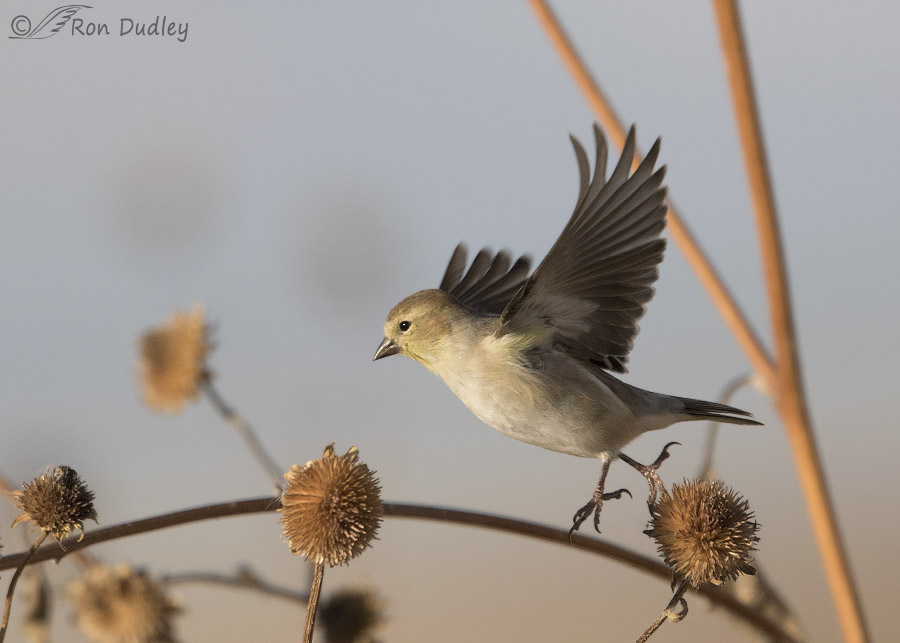
1/4000, f/6.3, ISO 640, Canon 7D Mark II, Canon EF 500mm f/4L IS II USM + EF 1.4 III Extender, not baited, set up or called in
I rarely post goldfinches to my blog but yesterday morning they were one of the few species still feeding on the sunflowers on the island (along with a few blackbirds). I liked this takeoff posture partly because of the combination of the position of the feet and the direction of the birds stare which for me both imply that the goldfinch is attempting to half-walk and half-fly along the curved stem below it. It wasn’t but it still amuses me for some reason.
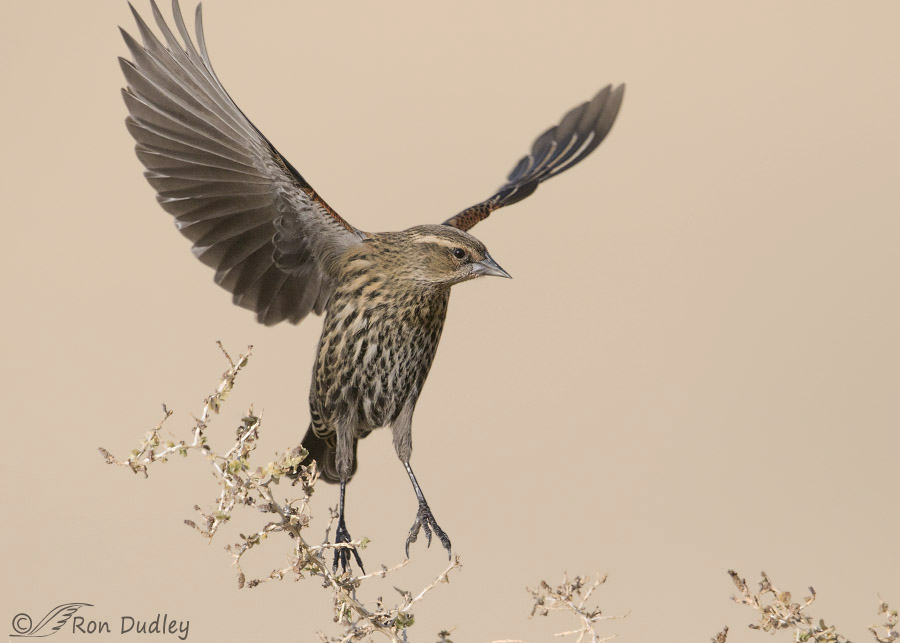
1/6400, f/6.3, ISO 640, Canon 7D Mark II, Canon EF 500mm f/4L IS II USM + EF 1.4 III Extender, not baited, set up or called in
It isn’t terribly unusual for smaller songbirds to take off vertically but in my experience larger and heavier birds like this female Red-winged Blackbird seldom do. So I was quite disappointed to have clipped a wing when this one took off with her heavy body hanging almost straight down from her wings. I have a working theory that this happens most often with heavier birds when they’re perched on unusually flimsy and flexible perches that bend backwards when the bird attempts to push off from them.
Whatever the reason for it I like the incongruity of this hanging takeoff posture from such a relatively heavy bird.
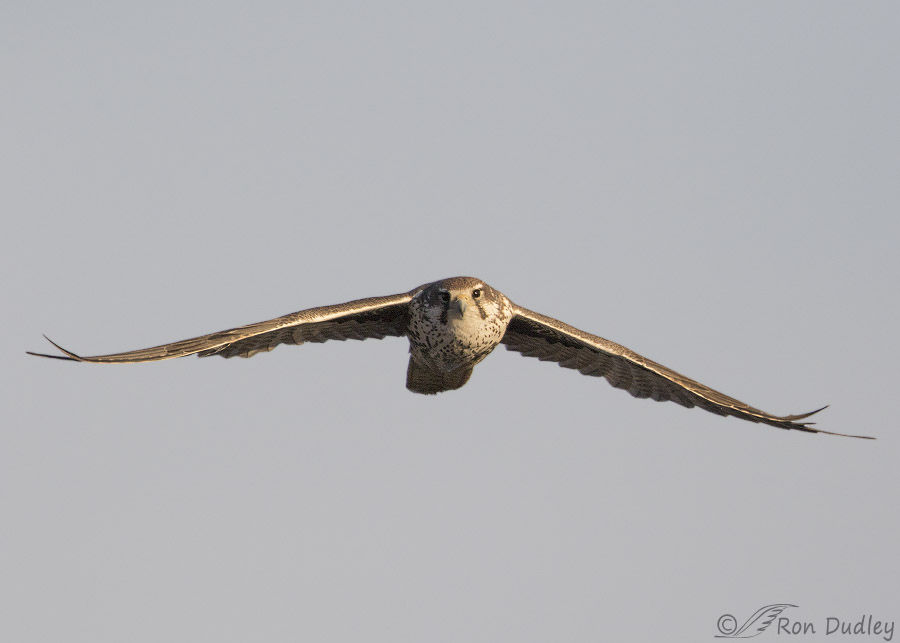
1/4000, f/6.3, ISO 500, Canon 7D Mark II, Canon EF 500mm f/4L IS II USM + EF 1.4 III Extender, not baited, set up or called in
My biggest frustration of the morning came from this Prairie Falcon that twice (count’em, twice!) stymied my attempts at quality photos of it. It let me approach relatively close (for a Prairie Falcon) as it was perched on a pole so I had high hopes for decent takeoff and flight shots but to get an angle I could shoot from out of my pickup I had to turn to my right for a couple of feet just before I came to a stop. As soon as the falcon saw the angle of my barely moving pickup start to change it took off before I got my lens on it. I don’t like to flush birds, raptors especially, so I wish I’d stayed a little further away. Next time I will.
But the falcon wasn’t through frustrating me yet.
After taking off away from me it unexpectedly looped around and flew back in my direction. It passed frame-fillingly close to my pickup but it was very soon after dawn and the bird was strongly sidelit so as often happens in these situations my flight shots were soft and I was unhappy with the side light.
But I include this photo because of something that confuses me a little. In this and several other shots with the wings extended those wings look to be of equal length and symmetrical, just as one would expect.
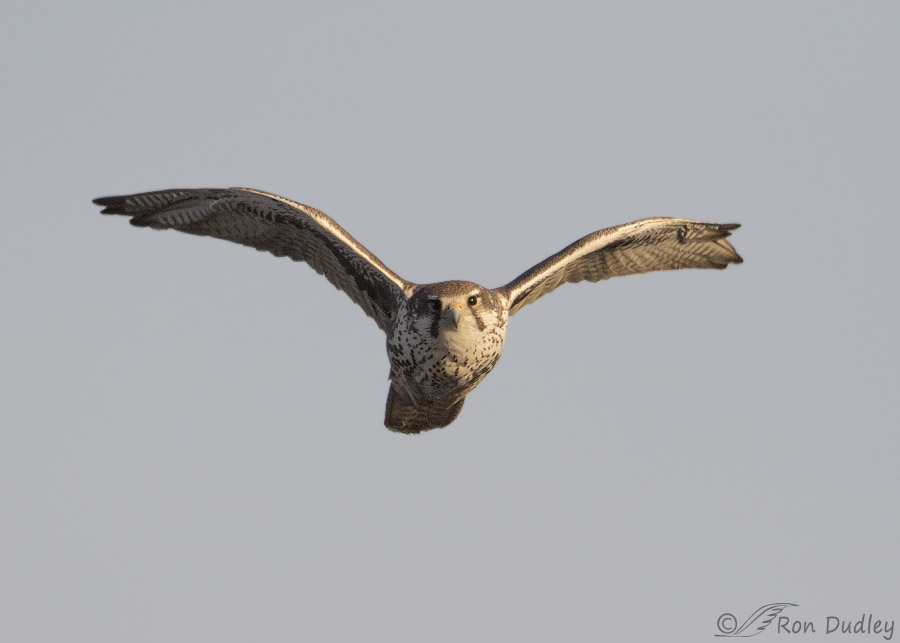
1/3200, f/6.3, ISO 500, Canon 7D Mark II, Canon EF 500mm f/4L IS II USM + EF 1.4 III Extender, not baited, set up or called in
But in other photos of the same bird (usually when its wings were curved instead of straight out) the two wings appear asymmetrical with the left one shorter than the right.
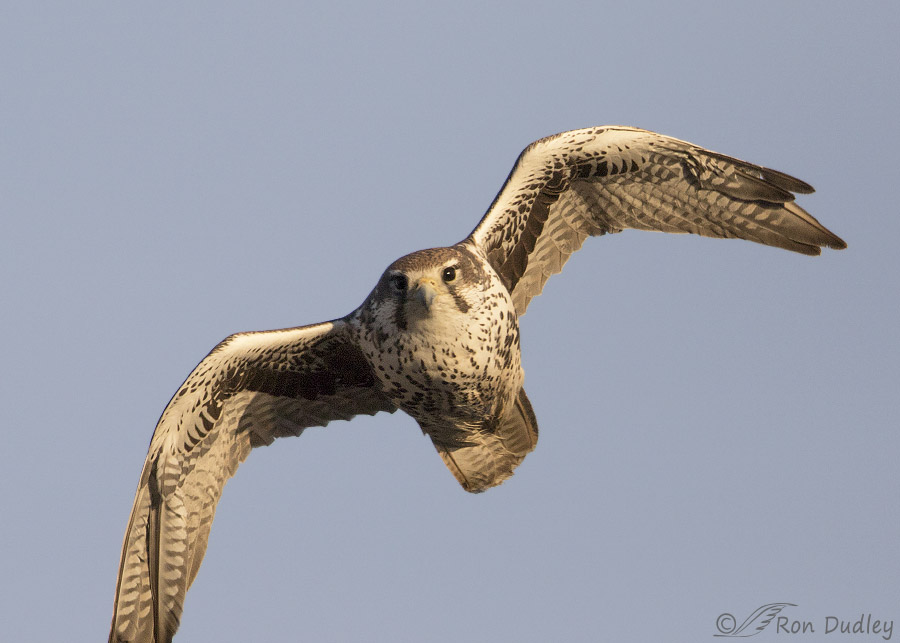
1/5000, f/6.3, ISO 500, Canon 7D Mark II, Canon EF 500mm f/4L IS II USM + EF 1.4 III Extender, not baited, set up or called in
When the bird banked and gave me better light underneath the image was a little sharper so I got a better look at that left wing tip (naturally I cut off the other one). Several primaries at the tip of that wing appear to have been molted simultaneously and their replacements are still growing out but that’s apparently not the case on the right wing. If I’m interpreting what I’m seeing correctly it surprises me a little because it’s my understanding that raptors usually lose wing feathers simultaneously and symmetrically – the same feather on both wings at roughly the same time to give them balance in flight.
Much ado about nothing I’m sure but I do tend to focus on things I don’t understand. I just wish I knew more about molting in raptors.
Ron


Late to the party – but it gives me the benefit of reading more comments from erudite people. Will learnng about moulting patterns in raptors be useful for me? Possibly not but my eclectic grab-bag of a mind is grateful anyway.
Always and never are dangerous words aren’t they?
And yes, I loved the photographs too.
You can be late to my party anytime, EC.
Splendid shots as usual. (Insert string of OH WOWs here!).
Just thought I’d mention that it’s good to be easily amused, to question everything and to be regularly flummoxed by prairies. A falconer friend here has been trying to trap a young prairie falcon for several weeks now and she’s eluded his every attempt. Same thing happened to him last year, making him wonder if this year’s juvie and last year’s juvie came from the same wily parents.
Sounds like that Prairie Falcon is making sport of your friend, Laura. Made me smile.
Yep, it seems prairies like to make sport of humans. Personally, I maintain there’s no real sport in it. I mean, we’re just human
I love these images. Whatever you think of them Ron, I think these are beautiful and great action shots.
I’m glad you like them, Debbie. Thanks.
Nice collection of images Ron. I especially liked the first three – very good work.
Thank you, UBL.
Yes, raptors do normally molt symmetrically; however, there can be a couple of reasons why that would not happen. One is damage to the wing that affected the feather follicles. We have sometimes found birds with fractures of the metacarpals (fused digits that would be across our palm in humans) that heal fine but the feather follicles can be damaged and take a couple of molts before the feathers come in correctly. I’ve seen feathers that grow in backwards, even – i.e., facing h=the wrong way. Not the case here or he wouldn’t be flying. It’s also possible that he hit that wing on an obstacle when the last couple of feathers were in blood; when they break a blood feather, they will often pull the broken feather, and the follicle then needs to start over producing a new feather.
BUT also West Nile Virus sometimes affects the feathers, causing them to pinch off and fall out prematurely. Even a touch of the disease can leave an impact on the feathers that can take a while to grow in correctly.
Interesting info, Louise. Thank you for providing it. A friend says that he’s read that their normally symmetrical molt can also get out of sync when they’re raising youngsters but obviously that’s not the case here.
Louise, always good to hear from you! I had no idea it was possible for a feather to grow in backwards? EGADS!! But there’s my new information for the day!
But some raptors just didn’t get the memo about that orderly process thing. Richard Brunotte used to argue with me that they ALWAYS molted in a predictable and orderly fashion, and of course, I replied that Mariah (female redtail) just didn’t agree with that process and that she molted pretty haphazardly (although completely when she was done). A deck feather, for example, might be followed by out outside tail feather. A notched primary might be followed by an inside primary on the other side OR the same side. She just didn’t do the orderly thing. He didn’t believe me until he witnessed her erratic molting patterns first hand.
Then Jack (male HAHA) came along and he was the same way. Evidently, he didn’t get the memo, either. Oh and neither of them has raised youngsters, so there’s that idea flung into the garbage bin with these guys.
Just goes to show that you should always avoid the concepts of always and never because there’s always a smartass (or several) in the group (tongue firmly in cheek)
Seeing all of these photos is enjoyable. My favorite is the Goldfinch, because of the feet. Your description of what it’s doing makes me wish I had wings to help me on the rocks at the park…
I use a cane , but wings would be much better!!!
I could use wings these days too, Susan…
An interesting series…the first because of the flight-hop action, the second because of the obvious verticality And the third because of the mysterious appearing-disappearing primary-primaries, and the last is interesting because it shows so well the pocket the missing primary is supposed to slip into. (It sure doesn’t seem to be missing any feathers in the preceeding, head-on photo).
Thank you, Patty.
Beautiful! I’m still pining away for a prairie falcon siting…I’ve seen only one and from such a great distance that my photos are a blurry mess. What I wouldn’t give to see one as close as you did in these images. I love all these images even though you find fault with them!
Sharon, I saw another PRFA this morning in Tooele County but it was far away and I had no way to get closer.
Super series Ron!
Charlotte
Thanks, Charlotte.
Productive even if frustrating morning! The wings being asymmetrical would seem to me to cause flight issues for the bird – interesting! Suspect the female red wing blackbird’s vertical take off might not be that unusual given, at least here, they frequent the cat tails which can offer tight quarters at times. The gold finch appearing to half hop/half fly is a great capture.
The wings being asymmetrical would seem to me to cause flight issues for the bird – interesting! Suspect the female red wing blackbird’s vertical take off might not be that unusual given, at least here, they frequent the cat tails which can offer tight quarters at times. The gold finch appearing to half hop/half fly is a great capture.  What’s “different” often catches my eye also.
What’s “different” often catches my eye also.
You’re probably right about the cattails and black birds, Judy. Thanks.